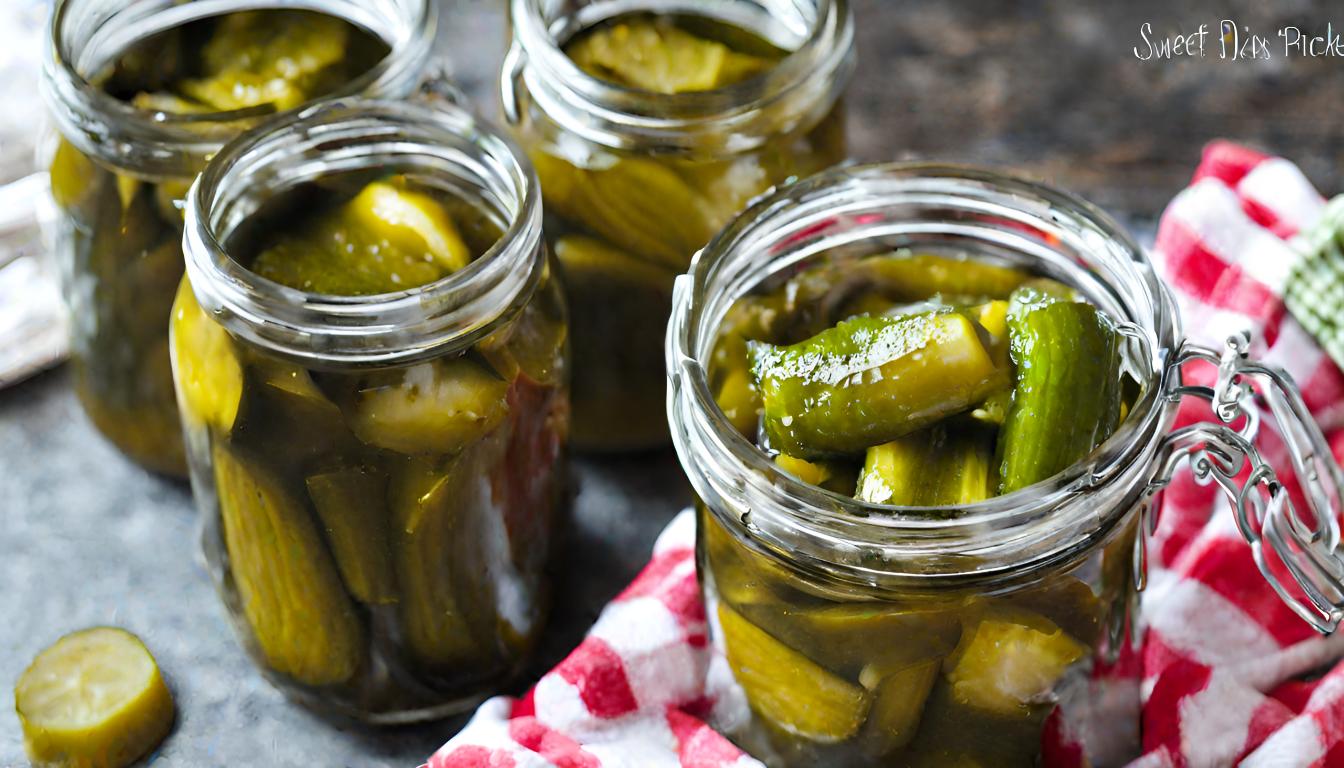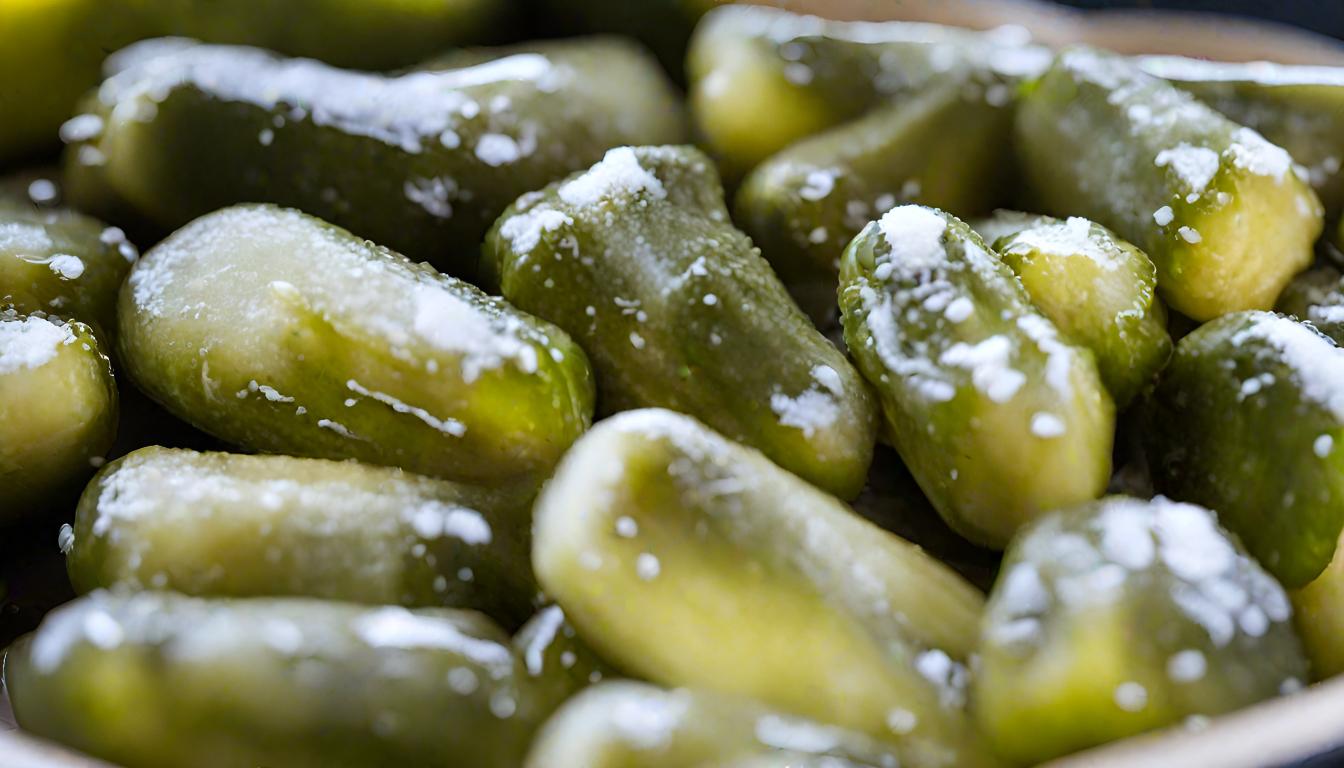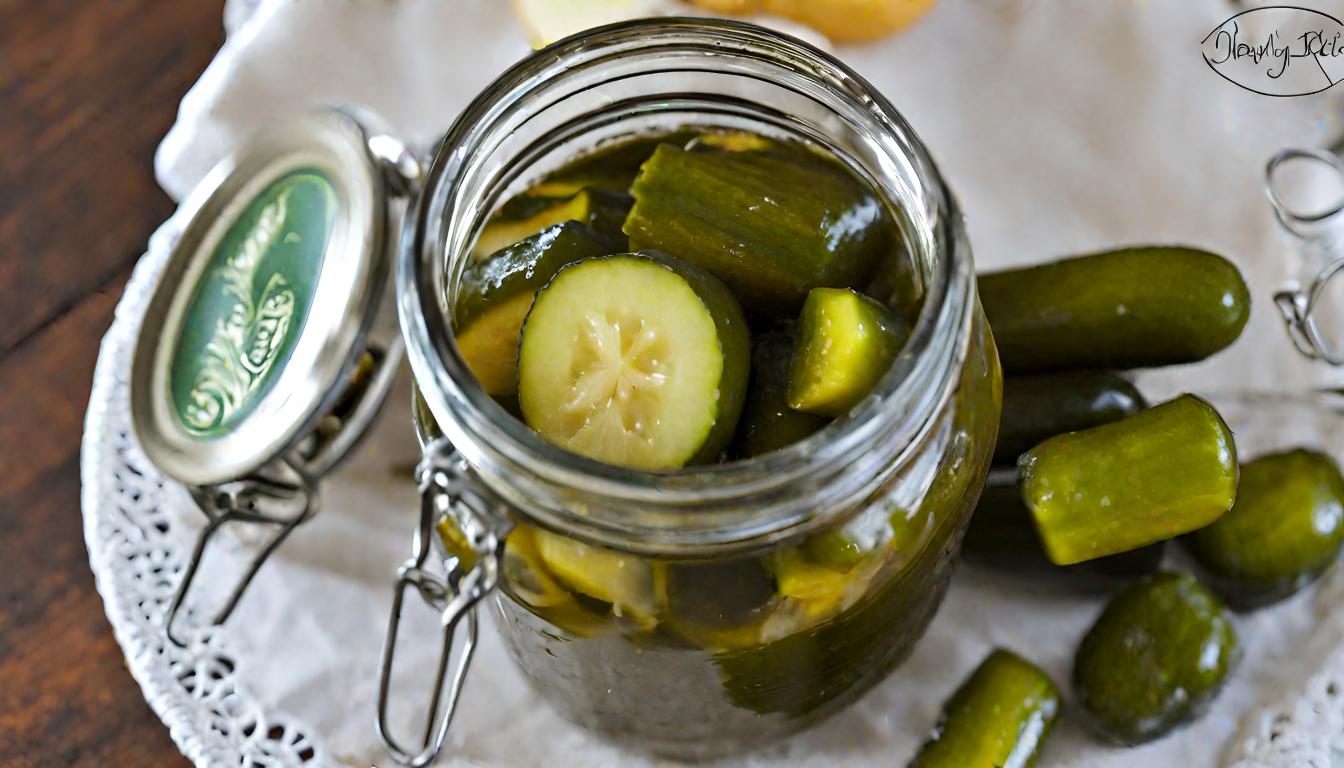Embarking on a culinary journey through the art of pickling, this article delves into the world of 3-day sweet pickles recipe, a delightful treat that marries the crunch of fresh cucumbers with a sweet and tangy brine. From the roots of pickling history to the intricate steps of creating these delicious morsels, we’ll guide you through every aspect recipe, ensuring your pickling adventure is both successful and enjoyable
Introduction to Sweet Pickles
A Brief History of Pickling
Pickling, the ancient art of preserving foods, has a storied history dating back over 4000 years. Originating as a necessity to preserve food for out-of-season use and for long journeys, especially by sea, pickling has evolved into a culinary craft celebrated worldwide. The process, which began with salting and fermenting, now embraces a variety of flavors and techniques, with sweet pickles being a particularly beloved variant.
The Importance of Sweet Pickles in Various Cuisines
Across the globe, sweet pickles grace tables in many forms, from the tangy accents in American burgers to the spicy undertones in Indian meals. Their versatility and unique flavor profile have made them an indispensable part of many culinary traditions. Whether served as a condiment, a snack, or a palate cleanser, sweet pickles add a burst of flavor and texture that enhances the dining experience.
Overview of the Recipe Process
The recipe is a testament to the patience and care that goes into traditional pickling methods. This process involves soaking cucumbers in a saltwater solution, changing the brine to infuse flavors, and finally, sealing the pickles in a sweet vinegar mixture. The result? Crunchy, flavorful pickles that are worth the wait. This method not only preserves the cucumbers but also transforms them into a delectable treat that’s both nostalgic and refreshing.
In the following sections, we’ll explore the ingredients and equipment you’ll need, provide a step-by-step guide to making these pickles, and share tips and tricks to ensure your pickles turn out perfectly. Whether you’re a seasoned pickler or new to the craft, this guide will equip you with the knowledge to create delicious 3-day sweet pickles that are sure to impress.
Stay tuned as we embark on this pickling adventure, ensuring each step is clear, concise, and easy to follow. By the end, you’ll not only have a batch of irresistible sweet pickles but also a deeper appreciation for the art of pickling itself.
Ingredients and Equipment Needed
Ingredients for 3-Day Sweet Pickles

To embark on this pickling adventure, you’ll need:
- Cucumbers: Opt for fresh, firm cucumbers. The quantity may vary based on the size of your jars, but generally, 5-6 medium cucumbers are a good start.
- Salt: A crucial ingredient for the initial brining process. You’ll need about 1 cup of non-iodized salt for a gallon of water.
- Sugar: The sweetness in your pickles comes from sugar. Prepare to have around 3 cups of granulated sugar.
- Vinegar: Essential for the pickling liquid. White vinegar, with its clean, sharp taste, is preferred, amounting to about 4 cups.
- Water: Plays a role in both the brining and the pickling process. Have at least 2 cups for the pickling mixture and more for the initial brine.
- Spices: Allspice and a pinch of alum (for crispness) add depth to the flavor. You’ll need ½ teaspoon of allspice and a small pinch of alum per jar.
Equipment Needed
The right tools can make the pickling process smoother and more enjoyable:
- Large Pot: For boiling the brine and later the pickles.
- Glass Jars with Lids: Sterilized jars are essential for storing your pickles. Depending on the size, you’ll need enough to hold your batch.
- Measuring Cups and Spoons: Precision is key in pickling, so have these ready for accurate measurements.
- Cutting Board and Knife: For preparing your cucumbers.
- Large Bowl: Needed for the initial soaking of cucumbers in the brine.
- Jar Lifter: A handy tool for safely removing hot jars from boiling water.
- Canning Funnel: Helps in transferring the pickles and brine into jars without mess.
With your ingredients and equipment ready, you’re set to begin the pickling process. These essentials will guide you through the initial preparation of the cucumbers to the final act of sealing them in jars, filled with a sweet and tangy brine. In the next section, we’ll delve into the step-by-step process of making 3-day sweet pickles, ensuring your success in creating this timeless delicacy.
Remember, the quality of your ingredients and the precision of your equipment setup can significantly influence the outcome of your pickles. So, take a moment to gather everything you need, and let’s prepare for the exciting steps ahead in this pickling journey.
Step-by-Step Recipe

Day 1:
The first day is all about setting the stage for the flavors to meld.
- Cleaning and Cutting the Cucumbers: Begin by thoroughly washing your cucumbers to remove any dirt or pesticides. Depending on your preference, you can slice them into rounds, spears, or leave them whole. Just remember, the size and shape will affect the pickling time and texture.
- Soaking in Saltwater Solution: In a large bowl, dissolve 1 cup of salt in 1 gallon of water. Submerge your cucumber slices or spears in this brine. The saltwater brine is crucial for drawing out moisture from the cucumbers, which helps in achieving that desired crunch. Cover the bowl and let it sit at room temperature for 24 hours.
Day 2: Changing the Brine
This step is vital for developing the pickles’ flavor and texture.
- Draining the Cucumbers: After 24 hours, drain the cucumbers from the initial brine and rinse them under cold water. This step removes excess salt.
- Preparing a Fresh Brine: In a large pot, mix 2 cups of vinegar with 1 cup of water and bring it to a boil. Once boiling, remove from heat and let it cool slightly. Pour this mixture over the cucumbers, then cover and let them sit for another 24 hours. This vinegar bath starts the pickling process, infusing the cucumbers with a tangy flavor.
Day 3: Finalizing the Pickles
The final day is when your pickles come to life.
- Boiling the Pickles with Vinegar and Spices: Drain the cucumbers from the vinegar solution. In the same large pot, combine 3 cups of sugar, the remaining 2 cups of vinegar, and ½ teaspoon of allspice. Heat until the sugar dissolves. Add the cucumbers to the pot and bring to a boil. This step not only sterilizes the pickles but also ensures they absorb the sweet and tangy flavors fully.
- Jar Sealing and Storage Tips: Carefully pack the hot pickles into sterilized jars, leaving a bit of space at the top. Pour the hot vinegar mixture over the cucumbers, ensuring they are completely submerged. Wipe the rims of the jars with a clean cloth, place the lids on top, and screw the bands on tightly. For long-term storage, process the jars in a boiling water bath for 10 minutes. Once cooled, check the seals, label your jars with the date, and store them in a cool, dark place.
By following these detailed steps over three days, you’ll create sweet pickles that are not only a treat to the taste buds but also a testament to the timeless art of pickling. These pickles can be enjoyed immediately or allowed to mature, developing deeper flavors over time.
In the next section, we’ll share some tips and tricks to ensure your pickles are as delicious as they are delightful, covering everything from maintaining crispness to exploring flavor variations. Stay tuned as we continue to unravel the secrets to perfect 3-day sweet pickles.
Tips and Tricks

Ensuring Crispness
One of the most cherished qualities of a good pickle is its crispness. Here’s how you can achieve that satisfying crunch:
- Use Fresh Cucumbers: The fresher the cucumbers, the crisper your pickles will be. Look for firm, vibrant cucumbers without any soft spots.
- Cold Water Bath: After slicing, immerse your cucumbers in an ice water bath for a few hours before pickling. This step can help firm up the cucumbers, leading to a crisper final product.
- Add Grape Leaves: Placing a grape leaf at the bottom of each jar is an old trick to maintain crispness. The tannins in grape leaves help keep the cucumbers firm.
Flavor Variations
While the classic sweet pickle flavor is beloved by many, don’t be afraid to experiment with different spices and ingredients to create your unique twist:
- Spice It Up: Consider adding spices like cinnamon sticks, cloves, or mustard seeds to the vinegar mixture for an extra layer of flavor.
- Sweet and Spicy: For a sweet and spicy version, add a few slices of jalapeño or a dash of red pepper flakes to each jar before sealing.
- Herbal Notes: Fresh dill, garlic cloves, or even a sprig of rosemary can add a refreshing herbal note to your sweet pickles.
Experimenting with these variations not only allows you to customize your pickles to your taste preferences but also adds an exciting twist to your pickling repertoire.
By keeping these tips and tricks in mind, you’re well on your way to creating 3-day sweet pickles that are not just a delight to eat but also a testament to your pickling prowess. Remember, the beauty of pickling lies in the journey as much as in the destination. Each batch is an opportunity to refine your skills and explore new flavors.
In the next section, we’ll address some common mistakes to avoid during the pickling process. This guidance will help ensure your pickling adventure is smooth and your pickles are perfectly preserved. Stay tuned as we delve deeper into the world of pickling, ensuring your success every step of the way.
Common Mistakes to Avoid
Overcrowding the Jars
- The Issue: Packing too many cucumbers into a jar can restrict the flow of the brine, leading to unevenly pickled cucumbers.
- The Solution: Leave enough space for the brine to circulate freely around each cucumber. This ensures each piece is evenly infused with the sweet and tangy flavors.
Using Iodized Salt
- The Issue: Iodized salt can introduce impurities and cloudiness to the brine, affecting the pickles’ flavor and appearance.
- The Solution: Opt for pickling or kosher salt, which is purer and ensures a clear brine, enhancing the pickles’ overall quality.
Ignoring the Importance of Vinegar Quality
- The Issue: Low-quality vinegar can impart an off-taste to your pickles, detracting from the desired flavor profile.
- The Solution: Use high-quality, clear vinegar for pickling. Apple cider vinegar for a milder taste or white vinegar for a sharper tang are excellent choices.
Skipping the Sterilization Step
- The Issue: Failing to properly sterilize jars and lids can introduce bacteria, risking spoilage and food safety.
- The Solution: Always sterilize your jars and lids by boiling them for 10 minutes before use. This step is crucial for long-term preservation and safety.
Inconsistent Slice Thickness
- The Issue: Cucumbers sliced into varying thicknesses can lead to uneven pickling, with some slices too soft and others too crunchy.
- The Solution: Aim for uniform thickness when slicing cucumbers. Using a mandoline slicer can help achieve consistent results, ensuring each slice pickles at the same rate.
By avoiding these common mistakes, you can significantly improve the outcome of your 3-day sweet pickles. Each batch of pickles is an opportunity to refine your technique and produce a product that is both delicious and visually appealing.
In the next section, we’ll address some frequently asked questions that arise during the pickling process. This FAQ will provide additional insights and tips to help you master the art of making sweet pickles, ensuring your questions are answered and your pickling journey is as smooth as possible. Stay tuned for valuable information that will further enhance your pickling expertise.
Frequently Asked Questions
How Long Do Sweet Pickles Last?
- Answer: Properly canned and sealed sweet pickles can last up to a year in a cool, dark place. Once opened, keep them refrigerated and consume within two months for the best quality.
Can I Use Different Types of Cucumbers for This Recipe?
- Answer: Yes, you can experiment with various types of cucumbers. However, smaller, firmer varieties like Kirby or Persian cucumbers are ideal for pickling due to their crisp texture and smaller seeds.
What Are the Best Jars for Storing Pickles?
- Answer: Glass canning jars with tight-fitting lids are best for storing pickles. They’re durable, non-reactive, and provide an airtight seal that preserves the pickles’ flavor and freshness.
Can I Adjust the Sweetness of the Pickles?
- Answer: Absolutely! Feel free to adjust the amount of sugar based on your taste preference. Reducing the sugar will yield a tangier pickle, while increasing it will enhance the sweetness.
Why Are My Pickles Soft Instead of Crisp?
- Answer: Soft pickles can result from overprocessing, using overripe cucumbers, or not using a crisping agent like alum or grape leaves. Ensure you’re following the recipe closely and using fresh, firm cucumbers for the best texture.
Is It Necessary to Use a Water Bath for Sealing the Jars?
- Answer: While some recipes may not require a water bath, using one ensures the jars are properly sealed, extending the shelf life of your pickles. It’s a crucial step for long-term storage.
Can I Reuse the Brine for Another Batch of Pickles?
- Answer: It’s not recommended to reuse brine for new batches of pickles. Reusing brine can introduce bacteria and may not provide the same level of acidity needed for safe preservation.
By addressing these FAQs, we hope to have clarified some of the nuances involved in making 3-day sweet pickles. Each question brings us closer to perfecting the art of pickling, ensuring every batch is as delightful as the last.
In the concluding section of our guide, we’ll wrap up with a summary of the recipe and some final words of encouragement for your pickling adventures. Whether you’re a seasoned pro or a curious newcomer, the world of pickling welcomes you with open jars. Stay tuned for our wrap-up, where we’ll celebrate the joy of pickling and the satisfaction of creating something truly special from simple ingredients.
Conclusion
Wrapping Up
Making 3-day sweet pickles is more than just a culinary activity; it’s a foray into the rich traditions of food preservation that have been passed down through generations. This recipe not only yields deliciously sweet and tangy pickles but also offers a sense of accomplishment and connection to a broader culinary heritage.
- Remember the Basics: Fresh ingredients and precise measurements are the foundation of successful pickling. Ensuring your cucumbers are fresh and your ingredients are of high quality will set you up for success.
- Patience is Key: The 3-day process might seem lengthy, but it’s this slow transformation that imbues the pickles with their distinctive flavor and texture. Embrace the wait as part of the pickling charm.
- Experiment and Personalize: Once you’re comfortable with the basic recipe, don’t hesitate to experiment with flavors and spices. Making the recipe your own is part of the joy of cooking.
Encouragement to Experiment
The world of pickling doesn’t end with sweet pickles. There’s a vast array of vegetables and fruits waiting to be transformed through the magic of brine and spices. Each batch of pickles is an opportunity to refine your skills, experiment with new flavors, and share your creations with friends and family.
- Explore Further: Dive deeper into the art of pickling by exploring other recipes and techniques. Each type of pickle offers a unique flavor profile and learning experience.
- Share Your Creations: Pickles make wonderful gifts and are a delightful way to share your culinary adventures with others. Don’t hesitate to spread the joy of pickling.
In closing, we hope this guide has equipped you with the knowledge and inspiration to continue your pickling journey. Whether you’re savoring your 3-day sweet pickles as a snack, adding them to your meals, or sharing them with loved ones, remember that each jar is a testament to your dedication and passion for the craft of pickling.
Thank you for joining us on this flavorful adventure. May your jars always be full, and your pickles always crisp. Happy pickling!
